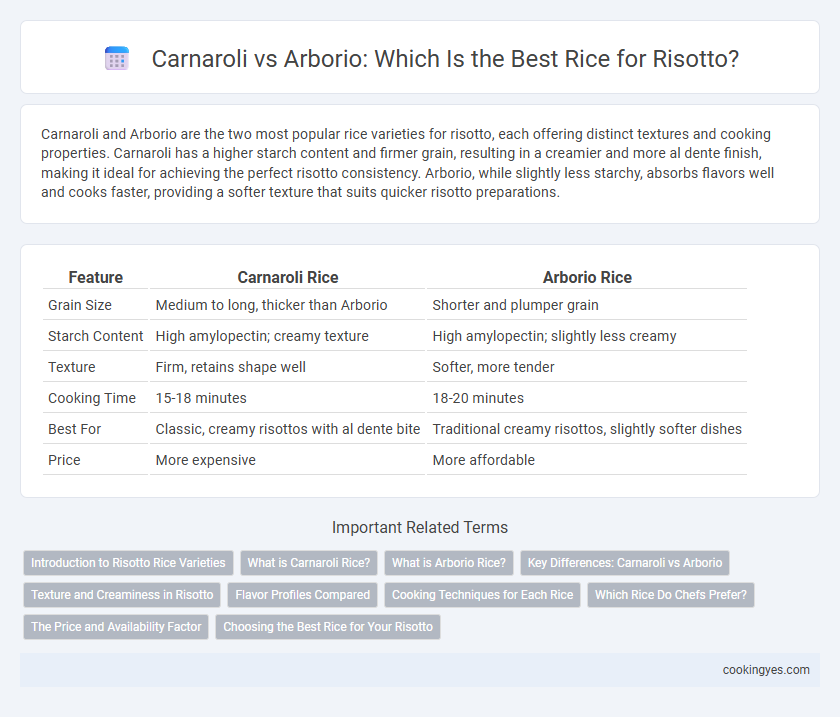Carnaroli and Arborio are the two most popular rice varieties for risotto, each offering distinct textures and cooking properties. Carnaroli has a higher starch content and firmer grain, resulting in a creamier and more al dente finish, making it ideal for achieving the perfect risotto consistency. Arborio, while slightly less starchy, absorbs flavors well and cooks faster, providing a softer texture that suits quicker risotto preparations.
Table of Comparison
| Feature | Carnaroli Rice | Arborio Rice |
|---|---|---|
| Grain Size | Medium to long, thicker than Arborio | Shorter and plumper grain |
| Starch Content | High amylopectin; creamy texture | High amylopectin; slightly less creamy |
| Texture | Firm, retains shape well | Softer, more tender |
| Cooking Time | 15-18 minutes | 18-20 minutes |
| Best For | Classic, creamy risottos with al dente bite | Traditional creamy risottos, slightly softer dishes |
| Price | More expensive | More affordable |
Introduction to Risotto Rice Varieties
Carnaroli and Arborio are two principal varieties of rice used for authentic risotto, each offering unique starch content and grain texture critical to the dish's creamy consistency. Carnaroli rice, known as the "king of risotto," boasts a higher amylose level, resulting in a firmer bite and excellent absorption of flavors without becoming mushy. Arborio rice, more widely available, has a slightly shorter grain with a higher amylopectin content, producing a creamier but softer texture ideal for traditional Italian risotto recipes.
What is Carnaroli Rice?
Carnaroli rice is a premium Italian grain renowned for its high starch content and firm texture, making it ideal for creamy risotto dishes. It absorbs liquids better than Arborio rice, allowing for a richer, silkier consistency while maintaining a slightly al dente bite. Chefs prefer Carnaroli for its superior ability to release starch gradually, resulting in a perfectly balanced and luxurious risotto.
What is Arborio Rice?
Arborio rice is a short-grain variety native to the Po Valley in Italy, renowned for its high starch content which creates a creamy texture essential for risotto dishes. Its plump, oval grains absorb liquid efficiently while maintaining a firm core, providing the ideal balance of creaminess and bite. Preferred in many traditional risotto recipes, Arborio rice delivers a rich mouthfeel and versatility for layering flavors.
Key Differences: Carnaroli vs Arborio
Carnaroli rice boasts larger, firmer grains with a higher starch content, resulting in a creamier, more al dente risotto texture compared to Arborio. Arborio rice, while shorter and plumper, absorbs liquids quickly and offers a slightly softer, creamier consistency that suits traditional risotto dishes. The key difference lies in Carnaroli's superior starch retention and firmer bite, making it preferred by chefs for refined risotto recipes.
Texture and Creaminess in Risotto
Carnaroli rice delivers a firmer texture and superior creaminess in risotto due to its higher starch content and medium grain size, making it ideal for achieving a perfect al dente bite. Arborio rice, while creamier and more absorbent, often results in a softer texture that can become mushy if overcooked, appealing to those who prefer a richer, more velvety consistency. Chefs favor Carnaroli for its balance of structure and creaminess, ensuring each grain remains distinct while providing the classic luxurious risotto mouthfeel.
Flavor Profiles Compared
Carnaroli rice delivers a creamier texture and a subtly nutty flavor, making it ideal for rich, luxurious risottos. Arborio has a slightly firmer bite and a more neutral taste, allowing it to absorb stronger, varied seasonings in risotto dishes. Chefs often prefer Carnaroli for its ability to maintain structure while offering a silkier mouthfeel, enhancing the overall flavor profile.
Cooking Techniques for Each Rice
Carnaroli rice, known for its firm texture and high starch content, requires gentle stirring and precise timing to maintain its al dente quality during cooking. Arborio rice, with a creamier texture and softer grains, benefits from continuous stirring to release its starch evenly, creating a smooth, velvety risotto. Both varieties demand gradual addition of hot broth, but Carnaroli holds shape better under longer cooking, making it ideal for more elaborate risotto recipes.
Which Rice Do Chefs Prefer?
Carnaroli rice is preferred by many chefs for risotto due to its higher starch content and firmer texture, which yields a creamier and more al dente dish. Arborio rice is more widely available and budget-friendly, but it tends to release starch faster, resulting in a softer, less structured risotto. Professional chefs aiming for the perfect balance of creaminess and bite often choose Carnaroli to achieve authentic risotto consistency and flavor.
The Price and Availability Factor
Carnaroli rice, often dubbed the "King of Risotto," commands a higher price due to its superior starch content and creamier texture, making it pricier than Arborio, which is more widely available and budget-friendly. Arborio rice is commonly found in most supermarkets, offering easy accessibility for home cooks, whereas Carnaroli is typically stocked in specialty or gourmet stores, affecting its availability. The cost difference impacts recipe budgeting, with Carnaroli preferred by chefs for authentic risotto despite its limited presence in everyday markets.
Choosing the Best Rice for Your Risotto
Carnaroli rice is often preferred by chefs for risotto due to its higher starch content and firmer texture, which yields a creamier and more al dente dish compared to Arborio. Arborio rice, while more widely available and affordable, tends to release starch quickly, resulting in a softer, less structured risotto. Choosing the best rice depends on the desired texture and cooking experience; Carnaroli offers superior creaminess and resilience, making it ideal for authentic, restaurant-quality risotto.
Carnaroli vs Arborio for risotto rice Infographic

 cookingyes.com
cookingyes.com